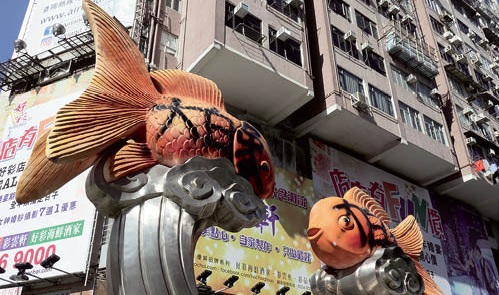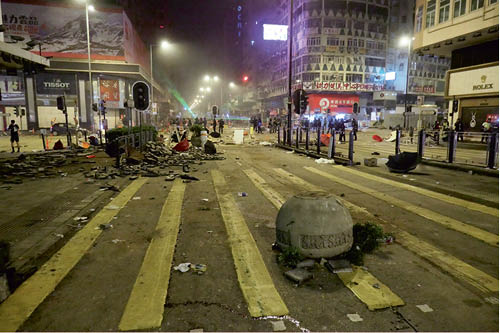Reviews & Articles
「靜雞雞」| Quietly (like a chicken)
John BATTEN
at 4:57pm on 22nd December 2019


圖片說明:
1. 太子水渠街休憩處的金魚雕塑
2. 2019年11月18日清早,彌敦道的街頭示威。
照片由作者提供
Captions:
1. Goldfish sculpture, Nullah Road Sitting-Out Area, Prince Edward.
2. Street protest, Nathan Road, early morning, 18 November 2019.
All Photos: John Batten
(Please scroll down for English version)
香港不久的將來,將會深受兩件被視為歷史上具決定性的關鍵事件影響。第一件是香港理工大學被示威者佔據後再被警察封鎖,然後是示威者全數撤離。一星期後,區議會選舉由民主派參選人取得選民的大比數支持,在十八個區議會中取得十七個的控制權。泛民現在已掌握區議會功能組別議席、選出下任行政長官的選舉委員會的一百一十七個議席,還有在下一屆立法會選舉中五個超級區議會議席的提名權。
曾聽過評論員說區議會是香港政府架構內的最底層,就像這級議會完全沒有權力一樣。說法略嫌誤導。區議會在制訂基層政策上所擔任的角色甚具影響力,特別是在城市規劃,以及管理居民區內的服務與設施方面。在保育古蹟和城市規劃主張的角力中,政府總會透過區議會諮詢來反映民意。舉例來說,任何市區重建局的項目、築路、公園「美化」或古蹟保育工程,在聆聽當區區議會意見後總會出現變數。另一方面,香港數以百計的諮詢委員會,還有各式官方活動,以後都會出現更多年輕新面孔,也有更多女性代表。區選促進了重大的世代更替,將會帶來社會一直需要的新意,而且肯定可抗衡表現不佳的小圈子區議會親政府決策。未來,我們應該會看到多一些規劃更佳的公共空間,少一些災難,例如是2011年油尖旺區議會通過的金魚雕塑劣作!
我在11月15日、17日和18日均有前往理大和鄰近範圍。在18號早上,我看到示威者燃起了一些可怕的熊熊大火,還有在理大和尖沙咀、佐敦和油麻地一帶,警方衝動作戰的思維。那一夜氣氛激烈得難以置信,容我另文再書。這次先憶述那個可怕晚上的一件事。
我在11月17號午夜前離開理大,但不久後便與一羣跟隨警察的記者會合,警察當時正在尖沙咀警署附近和示威者對峙,情況混亂一片:警察向着前線示威者施放一輪又一輪的催淚彈和橡膠子彈,示威者以汽油彈還擊,其中一枚汽油彈在警署停車場燒成大火,火勢延及一段彌敦道。最後,示威者退至裕華百貨後。當我差不多到達彌敦道/佐敦道交界時,我看到一名示威者躺在地上,被警察包圍,附近是其他被捕的示威者。一名年輕記者請我靠近一些,看看這位年約二十歲的女示威者有沒有呼吸。我向警察方向行近,看到女示威者的嘴唇在微動,正在呼吸,另外有一名警察正拿着一塊布來止血,她似乎頭部受了重傷。我把情況轉告記者,她請我打電話召救護車,她說外國人撥出的求救電話有較大機會被聽見,而且「警察不會打這通電話」。我撥了999,道明了地點和關於受傷女士的情況。999接線生說救護車會打電話給我。救護車的確約在兩分鐘後很快便回電給我。我跟救護車說,警察正支持着女傷者頭部等資料─救護車說較早時已有人報案,為那個地方的女傷者求助(所以其實已有人報案,又或警察方面已經報案)。
那裏的街道滿佈頹垣敗瓦,地上的小石令車輛寸步難行,即使伊利沙伯醫院就在一分鐘以外的轉角處,救護車最少花了十五分鐘才到達……與此同時,警察和示威者繼續在50米以外的地方火來彈往,互相發射火種、橡膠子彈、催淚彈和汽油彈。最後,警察沿彌敦道把示威者驅往油麻地方向。在我隨其他記者跟着前線時,我再次遇上之前的年輕記者(當所有人都戴上頭盔掩着臉,要認出對方真的很困難),她一直在那位女傷者附近守候,女傷者已得到救護員照料,坐了起來而且神智清醒,她頭上包着繃帶,由兩名警察監守(她稍後無疑會在醫院被捕)。那位記者感謝我出手相助;相對於她默默協助那位女傷者,我所做的真是微不足道。我問她來自哪個媒體,她輕聲說出,但我卻聽不見。她在電話上打出了”TVB”。我看看她,點了頭。我們周圍還有其他攝影記者在錄影,她不想讓他們知道。
這位來自TVB的年輕記者,在我有生以來見過最惡劣最暴力的街頭事件中,悄悄地伸出人道援手。這種仁慈,和我過去五個月來看過無數次的善心如出一轍。然而,我在過去幾個月內,見過各種在警察和示威者中間、或只源於某人職業(例如來自TVB的員工)和出身(例如來自內地)的污衊,那也是我看過最令人反感的事情。
自區議會選舉以來,示威者便一直討論「靜雞雞」行動。但願如此。這個城市亟須一個較寧靜的取向。如果示威者可以冷靜一些,政府便須兌現承諾回應示威者的核心訴求。立法會選舉就在十個月之後,到時候的政治風向可能會更進一步傾向泛民,進一步令我城撕裂,令政府更為人民仇恨。
原文刊於《明報周刊》,2019年12月6日
Quietly (like a chicken)
by John Batten
Two pivotal events will influence Hong Kong’s immediate future and be viewed as historically decisive. The first event is the occupation by protesters of the Polytechnic University, its siege and blockade by police and the subsequent complete evacuation of the campus by protesters. A week later, the District Council elections saw pro-democracy candidates secure majority support from the electorate to control 17 out the city’s 18 District Councils. The pan-democrats have now secured the dedicated District Council functional constituency seat, all 117 seats on the Election Committee to elect the next Chief Executive and have majority nomination rights for the five ‘super’ District Council seats in the next Legislative Council election.
I have heard commentators say that the District Councils are the “lowest rung” of government structure in Hong Kong, as if they have no power. That is a misleading representation. District Councils have an influential role in formulating grassroot policies, especially in urban planning, and in the management of residents’ local services and facilities. In our heritage conservation and urban planning advocacy battles, government always reflects public opinion by consulting District Councils. For example, any Urban Renewal Authority project, road construction, park ‘beautification’ or heritage conservation project will be varied after listening to the views of a local District Council. Furthermore, Hong Kong’s hundreds of advisory committees and official events will now see newer, younger faces, and more woman representatives. These elections have ushered in a pivotal generational change that will bring needed new ideas and will surely counter previously bad, small circle, District Council pro-government decision-making. In future, we should get better planned public spaces, and see fewer disasters, such as the kitsch goldfish sculpture that the Yau Tsim Mong District Council approved in 2011!
I visited the Polytechnic University and the surrounding areas on 15 November and again on 17 and 18 November. In the early morning of the 18th, I saw some awful fires lit by protesters, and an aggressive battle mentality by the police at the PolyU and on the surrounding streets of Tsim Sha Tsui, Jordan and Yau Ma Tei. It was an incredibly intense night, of which I will write another time. I will relate just one incident from that awful night.
I left the PolyU just before midnight on 17 November, but later was with a group of press following the police as they confronted protesters near Tsim Sha Tsui police station. It was a mess – round after round of tear gas and rubber bullets were fired by police at the frontlines of protesters, who replied with thrown Molotov cocktails, one starting a big fire in the police station carpark and fires along the length of Nathan Road. Eventually the protesters retreated past Yue Hwa Department Store. As I approached the Nathan Road/Jordan Road intersection, I saw a protester lying on the ground, surrounded by police, nearby were other arrested protesters. A young press reporter approached me and asked me to get closer and check if the protester (a woman aged about 20 years old) was breathing. I went near the police and noted that the woman’s lips were slightly moving and she was breathing and that a policeman was holding a cloth to stem the flow of blood from what looked like a serious head injury. I told the young press reporter and she asked if I could call an ambulance as a foreigner will have a better chance of being listened to, and “that the police won’t ring”. I rang ‘999’ and gave location and a short description of the woman’s injuries. The ‘999’ receptionist said the ambulance would ring me back. They did, promptly, about two minutes later. I told the ambulance that the police were holding the woman’s head etc etc – the ambulance said that they had had another report of a woman injured in that location (so, someone or the police did make a report).
The streets in the area were littered with debris, and stones made vehicle access difficult, so it took the ambulance at least fifteen minutes to arrive, despite Queen Elizabeth Hospital being one minute just around the corner….in the meantime, police and protesters continued trading fire with rubber bullets, tear gas and Molotov cocktails only 50 metres away. Eventually the police forced the protesters down Nathan Road towards Yau Ma Tei. But, before I followed the frontline with the other press, I saw the young press reporter again (it is always difficult to distinguish each other, as everyone is wearing helmets and faces are covered). She had stayed near the injured woman, who was now being attended by ambulance officers and was sitting upright and conscious, a large bandage around her head and guarded by two police (she will, no doubt, later be arrested in hospital). The reporter thanked me for my help – which was minor, compared to the quiet assistance she had offered to the injured woman. I asked her who she worked for. She whispered something that I did not hear. She then typed out on her phone “TVB”. I looked at her and nodded. There were still a couple of video press reporters filming around us, she did not want them to know.
The quiet humanitarian kindness by this young TVB press reporter, done during some of the nastiest and most violent street action I have seen, is typical of the kindnesses I have seen countless times over the last five months. However, the vilification of people, between police and protesters, or, merely based on their employment (e.g. working at TVB) or origins (e.g. from the mainland) have been some of the most distasteful incidents I have witnessed over the months.
Since the District Council election, protesters have been discussing to be ‘jing gai gai’ (quieter) in their actions. Let’s hope so. The city desperately needs a quieter approach. And, if protests are calmer, the government must fulfil its promise to address the protests’ core demands. The Legislative Council election are only ten months away, and the political balance could shift further towards the pan-democrats: further splitting the city into two and making the government an even bigger nemesis of the people.
This article was originally published in Ming Pao Weekly on 6 December 2019. Translated into Chinese by Aulina Chan.
